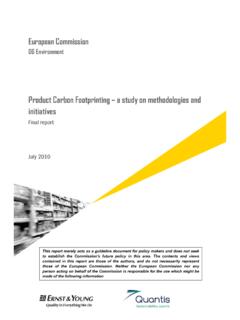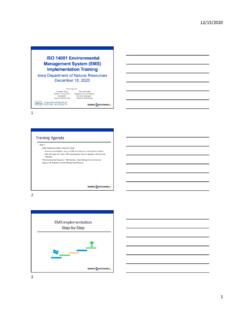Transcription of Taxonomy: Final report of the Technical Expert Group on ...
1 taxonomy : Final report of the Technical Expert Group on Sustainable Finance March 2020 - 2- What is the EU taxonomy ? AT A GLANCE The EU taxonomy is a tool to help investors, companies, issuers and project promoters navigate the transition to a low-carbon, resilient and resource-efficient economy. The taxonomy sets performance thresholds (referred to as Technical screening criteria ) for economic activities which: make a substantive contribution to one of six environmental objectives (Figure 1); do no significant harm (DNSH) to the other five, where relevant; meet minimum safeguards ( , OECD Guidelines on Multinational Enterprises and the UN Guiding Principles on Business and Human Rights).
2 The performance thresholds will help companies, project promoters and issuers access green financing to improve their environmental performance, as well as helping to identify which activities are already environmentally friendly. In doing so, it will help to grow low-carbon sectors and decarbonise high-carbon ones. The EU taxonomy is one of the most significant developments in sustainable finance and will have wide ranging implications for investors and issuers working in the EU, and beyond. Substantially contribute to at least one of the six environmental objectives as defined in the Regulation Do no significant harm to any of the other five environmental objectives as defined in the proposed Regulation Comply with minimum safeguards Climate change mitigation Climate change adaptation sustainable and protection of water and marine resources; transition to a circular economy pollution prevention and control; protection and restoration of biodiversity and ecosystems.
3 - 3- About this report The taxonomy Regulation (TR), agreed at the political level in December 2019, creates a legal basis for the EU taxonomy . The TR sets out the framework and environmental objectives for the taxonomy , as well as new legal obligations for financial market participants, large companies, the EU and Member States. The TR will be supplemented by delegated acts which contain detailed Technical screening criteria for determining when an economic activity can be considered sustainable, and hence can be considered taxonomy -aligned. The European Commission established a Technical Expert Group on Sustainable Finance, which was tasked with developing recommendations on a range of topics, including what the taxonomy Technical screening criteria should be for the objectives of climate change mitigation and adaptation.
4 This report sets out the TEG s Final recommendations to the European Commission. This report contains recommendations relating to the overarching design of the taxonomy , as well as guidance on how users of the taxonomy can develop taxonomy disclosures. It contains a summary of the economic activities covered by the Technical screening criteria. This report is supplemented by a Technical Annex containing: A full list of revised or additional Technical screening criteria for economic activities which can substantially contribute to climate change mitigation or adaptation (including assessment of significant harm to other environmental objectives); and Methodological statements to support the above recommendations. These recommendations have been developed over 20 months and with substantial consultation and scientific and Technical input.
5 The TEG has received input from all parts of the investment chain, industry sector representatives, academia, environmental experts, civil society and public bodies. Combined, these reports contain detailed explanation of the rationale and methodologies behind the TEG s conclusions. These reports supersede the two previous reports from the TEG (early feedback report Dec 2018, Technical report June 2019). This report represents the overall view of the members of the Technical Expert Group . However, although it represents such a consensus, it may not necessarily, on all details, represent the individual views of member institutions or experts. The views reflected in this report are the views of the experts only. This report does not reflect the views of the European Commission or its services.
6 - 4- Contents 1 Recent developments 7 Urgency and transition 7 The European Green Deal 8 taxonomy Regulation 9 Technical Expert Group : work programme 10 Mandate of the TEG 10 Call for feedback 10 Second extension of the TEG 12 2 Recommendations: taxonomy design 13 Overarching design issues 13 Sectors covered and not covered yet by the taxonomy 13 Types of economic activity that substantially contribute 14 Improvement measures within an economic activity 15 Life-cycle considerations 16 Minimum safeguards 17 International use of the EU taxonomy 18 Climate change mitigation 19 EU climate change mitigation objectives 19 Substantial contribution to climate change mitigation 20 Avoiding significant harm to climate change mitigation 21 Climate change adaptation 22 Changes in the Final Regulation 22 Changes as a result of feedback received 23 Areas of development in the Technical work 23 Water; Circular Economy; Pollution.
7 Biodiversity 25 Changes in the Final Regulation 25 Changes resulting from feedback received 25 3 taxonomy in practice 26 Who has to do what, and by when? 26 Company disclosure 27 Summary of requirements 27 Financial metrics 28 Climate change mitigation and adaptation: differences in calculation methodologies 30 Due diligence: qualitative screening criteria and minimum safeguards 32 Sector classification 35 - 5- Disclosure on economic activities not yet covered by the taxonomy 36 Disclosures by environmental objective 37 Verification 37 Financial market participants 37 Summary of the taxonomy disclosure requirement 37 Which products must complete taxonomy disclosures? 38 Narrative disclosures 39 Proportion of the underlying funds that are taxonomy -aligned 40 Example methodology for equity investments 40 Comparing methodologies for equity and fixed-income disclosures 41 Presentation of the disclosure 41 Recommended methodologies for fund constituents 42 Where should disclosures be made?
8 43 Verification 44 Dealing with limited data 44 Sector classification 48 Step-by-step example of how to assess a company or investment portfolio 49 4 Looking forward 51 Towards a fully realised taxonomy 51 Explaining performance improvements in environmentally harmful activities 51 Common design principles for international taxonomy harmonisation 53 Recommendations for the Platform on Sustainable finance 54 Role of the Platform 54 Call for feedback 54 Ongoing development of Technical screening criteria 54 5 Summary tables of the taxonomy 56 Substantial contribution to climate change mitigation 56 Substantial contribution to climate change adaptation 60 6 Acknowledgements 64 - 6- - 7- 1. Recent developments URGENCY AND TRANSITION Since the TEG commenced work in June 2018, the urgency of the environmental challenges we face has increased.
9 Despite clear emission reduction objectives agreed in the 2015 Paris Agreement on Climate Change, global greenhouse emissions have continued to climb until 2019 where they flatlined. There is now scientific consensus2 that global emissions must drop by 50% over the next decade for the world to have a chance of staying at degrees of global warming and thus avoid the most catastrophic consequences of climate This has clear and immediate implications for businesses. The impacts of climate change are now inevitable. The last two decades included 18 of the warmest years on record, and Europe experienced extreme heatwaves in four of the last five years. Communities and businesses in Europe and around the world are already beginning to feel the impact of climate change, and will need to understand, and manage, the risks and effects that come from a changing climate.
10 We face continued environmental degradation on many fronts, with signs that we may be reaching several alarming tipping points, particularly in excessive air pollution, water stress and biodiversity loss that undermines our ecosystems, while progress towards a circular economy remains disjointed and Ecological destruction on this scale threatens human civilisation. The message on the urgency of environmental and climate risks is getting through. In its 15th Global Risks report published in January 2020, the World Economic Forum (WEF) found that, for the first time in the report s history, all of the top long-term risks by likelihood are environmental , and climate change is rated the biggest global However, despite widespread recognition of the challenges that humanity faces, the current level of action aimed at changing course is too weak.













